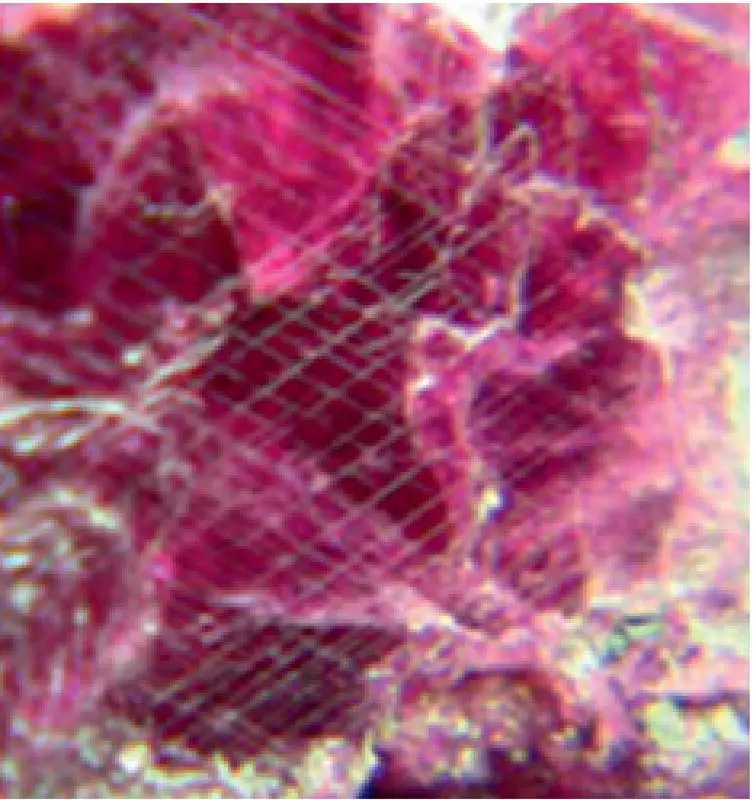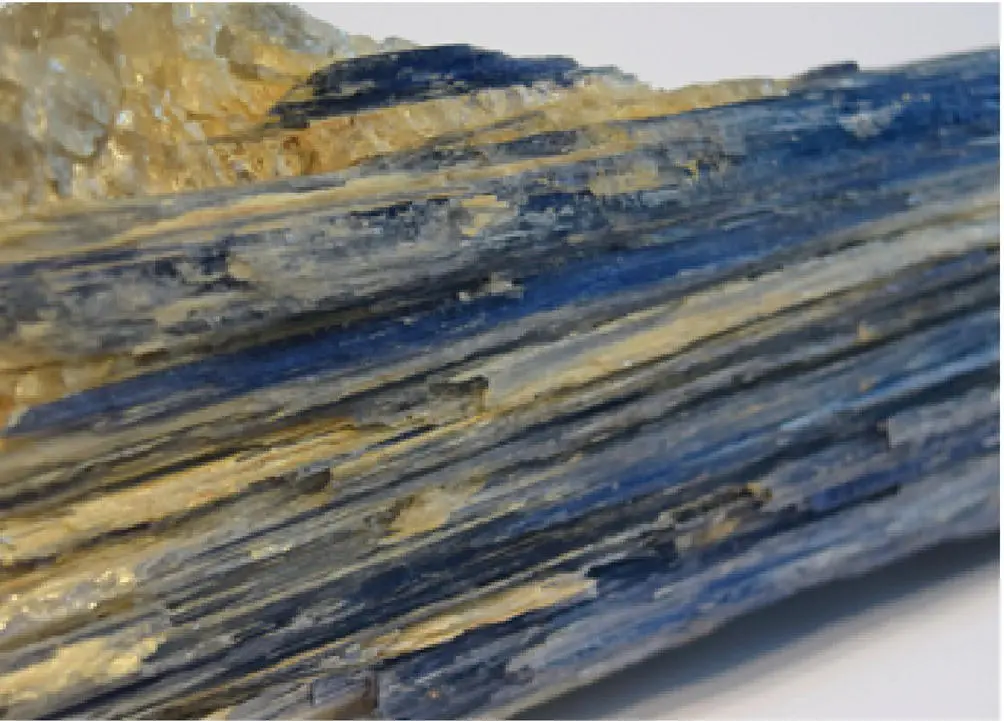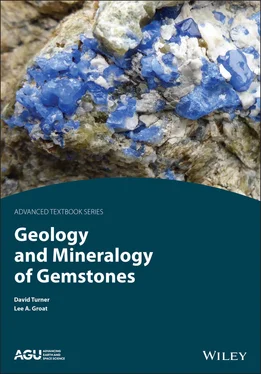
Figure 1.5 This crystal of corundum shows rhombohedral parting patterns and underlying irregular fractures.
Photo by D. Turner.
Specific Gravity (SG) is a measure of how heavy a material is for a given volume, defined by the weight of the material compared to the weight of water for an equal volume. Specific Gravity is unit‐less, which differs from density that is measured in g/cm 3or kg/m 3. The SG of water is 1, while that of diamond is 3.52. Most rock‐forming minerals (like quartz, SG = 2.65) have SG values between 2 and 3.5 while metal sulfides (like pyrite, SG = 5.0) and native metals (like gold, SG = 19.3) have higher SG values. This is sometimes referred to as heft.

Figure 1.6 This cluster of bladed kyanite crystals shows brittle tenacity and splintery parting, yellowish‐grey to blue coloration, and would exhibit lower hardness along the length of the crystals than across.
Photo by D. Turner.
Fluorescence is a consistent property of some minerals while in others it only occurs when certain impurities are present. Fluorescence is a phenomenon where light with greater energy (and shorter wavelength) excites electrons within a material and upon deexcitation (or relaxation) of the electron to ground state, a photon of lesser energy (and longer wavelength) is emitted. It is a type of luminescence. This is normally tested using ultraviolet light and observed in the visible range with the human eye; however, the process can be observed across a range of activating and fluorescent wavelengths. Fluorite is a common fluorescent mineral and some diamonds can be strongly fluorescent, yet neither of these minerals will always display fluorescence. Other types of luminescence include phosphorescence, thermoluminescence, triboluminescence, and cathodoluminescence.
1 Ball, S. H. (1935). A historical study of precious stone valuations and prices. Economic Geology, 30(5), 630–642.
2 Haxel, G. B., Hedrick, J. B., Orris, G. J., Stauffer, P. H., & Hendley II, J. W. (2002). Rare earth elements: Critical resources for high technology. Fact sheet No. 087‐02. United States Geological Survey.
3 Hazen, R. M., Grew, E. S., Downs, R. T., Golden, J., & Hystad, G. (2015). Mineral ecology: Chance and necessity in the mineral diversity of terrestrial planets. The Canadian Mineralogist, 53(2), 295–324.
4 Mason, B. & Moore, C. (1982). Principles of Geochemistry. New York: John Wiley & Sons.
2 Basics of Rocks and Geology
2.1 Earth System Science
Earth System Science views the Earth as a working system, each part having an impact and an effect on the other through geological time. To understand how the Earth creates beautiful and inspiring gems, all aspects of the Earth system must be appreciated, including the atmosphere, oceans, surface tectonic processes, processes deep in the Earth, and life ( Figure 2.1).
The significance of these components varies for the creation and preservation of different precious materials but all aspects tend to be tied together in one way or another. Diamonds, for example, predominantly form deep within the Earth in a region called the Upper Mantle, where very high pressures and temperatures exist. However, other processes, such as volcanism, are required to bring these diamonds through the mantle and crust to the surface. Natural processes on the Earth’s surface, such as glaciation, can move the diamonds away from their original source and leave a trail of ground kimberlite rock leading back to where the original deposit resides. Alternatively, if enough diamonds were moved by natural processes (e.g., river transport) from their primary geological location to a new secondary location, a diamond deposit could be formed far away from the original source rock. Even in this very limited example, the complexity and interconnectedness of the Earth system is obvious.
2.2 The Earth’s Structure and Plate Tectonics
Our solid planet is not homogeneous but is made up of a number of very distinct layers ( Figure 2.2). These layers, from exterior to interior, are:
Crust. The Earth’s crust is the uppermost layer. It represents ~1% of the total volume and generally consists of continental and oceanic crust. This uppermost layer is separated into a number of rigid sections, known as tectonic plates. Continental crust and oceanic crust have different overall compositions; continental crust has a higher silicon (Si) content but is more heterogeneous while oceanic crust has higher iron (Fe) content and is more homogeneous. Continental crust also tends to be much thicker than oceanic crust. The thickness of the continental crust is generally ~40 km, but reaches up to 60 km in mountainous areas and near 90 km is select locations. In contrast, oceanic crust is generally only ~10 km in thickness.
Mantle. The mantle comprises ~85% of the Earth’s volume and is hot and relatively viscous. The mantle is in continual motion with hot mantle material rising from depth and cooler upper mantle material sinking to the lower areas. These motions are called convection currents and may in part help drive the motion of the lithospheric plates. Figure 2.1 The Earth System. A schematic model of the Earth as a series of integrated systems. Drawn by G. Lascu. Figure 2.2 Simplified schematic of the Earth’s principal internal geological structure.The mantle is often divided into Upper Mantle, a Transition Zone, and the Lower Mantle. The Upper Mantle is distinct from the overlying crust and this boundary between layers is marked by a zone termed the Mohorovicic Discontinuity, defined by a distinct change in physical properties and geochemical composition, that occurs at a depth of ~7 km depending on local and regional conditions. The upper mantle material acts as a relatively soft, lubricating layer over which the crustal plates move.Greater depths and higher temperatures lead to other structural and mineralogical changes in the heterogeneous mantle, which give rise to a broad Transition Zone from ~410 to ~660 km depth, and the Lower Mantle from ~660 to ~2900 km depth.
Core. The core sits interior to the mantle and is divided into two parts. The outer core from ~2900 to 5150 km is molten metal while the inner core from ~5150 to 6370 km is solid and also of metallic composition. Both the inner and outer core regions have compositions dominated by iron and nickel.
The upper part of Earth’s structure can also divided based on rheological properties and how the material responds under tectonic forces. The lithosphere comprises the more rigid portion and consists of the crust and parts of the upper mantle that respond to tectonic forces in a predominantly cohesive and brittle manner. The asthenosphere exists within the mantle only and behaves in a ductile manner. The transition between the lithosphere and asthenosphere is dependent on local conditions; it can be as shallow as 50 km near spreading oceanic ridges or as deep as 250 km under old and stable continental plates, often termed cratons. At deeper regions, the asthenosphere transitions to the mesosphere, a more rigid zone within the lower mantle.
The theory of plate tectonics is sometimes called the Grand Unifying Theory of geology and began its formal development in the early twentieth century (Wegener 1912). It explains many of the geological phenomena that had puzzled scientists for so many years, such as the processes that build mountains and the patterns of distribution of earthquakes and volcanoes. The theory describes how the lithospheric plates and the continents they contain are pushed and pulled around the surface of the Earth. The surface of the Earth resembles a fractured eggshell with each fragment termed a plate ( Figure 2.3). Continental plates and oceanic plates are the two basic plate types. Continental plates are generally composed of many different rock types of diverse ages. Oceanic plates form at spreading ridges within an ocean basin and are overall higher in density than continental plates.
Читать дальше














